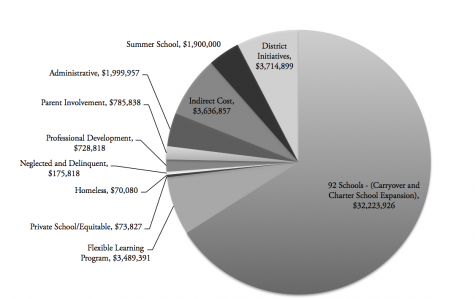Future Title I funds uncertain
August 23, 2016

APS fiscal year 2015 Title I allocation budget, including carryover funds from previous years.
Data from APS fiscal year 2015 budget.
Each year when Grady students return from summer break, they are met with neon purple, yellow and green forms to complete. While these routine forms may seem insignificant, they are part of the federal Title I program, which collects information on the school’s socioeconomic demographics to secure an estimated $200,000 in federal funding each year.
Last school year, Inman Middle School, the feeder school to Grady, lost this funding. This year, Grady stands to lose this sum as the school’s status under Title I remains in question.
Title I is a program created and funded by the U.S. Department of Education to provide additional funds to schools with high poverty.. To determine a school’s eligibility for Title I funding, state educational agencies rank school districts based on their poverty levels. The agencies then collaborate to grant Title I status to district schools with the highest percentages of low income students.
“Atlanta is at the top [in Title I funding] because we have high poverty,” said Kathleen Yarbrough, the Atlanta Public Schools’ Title I director.
According to Yarbrough, APS receives $29 million in Title I funding. In the past, the district received as much as $36 million.
Schools within APS qualify for Title I status based on the percent of students who are eligible for free or reduced lunch. Schools with over 75 percent of students qualifying for free or reduced lunch receive the same amount of funding annually, while schools with 35-to-40 percent qualifying achieve Title I status and receive funding based on their rank.
In order to receive this funding, Title I schools must adopt a school wide academic plan, which maps out how the school will educate students and make academic progress to meet state standards. Those schools hold meetings with the community to gather input for the plan, and once the plan is put into action, their progress is monitored by local education agencies.
According to Jacqueline Marable, Grady’s parent liason, which is funded by Title I, keeping parents updated and receiving their input is vital to the program.
“We had a Title I meeting in July and only two parents showed up out of 1,300,” Marable said. “I try to tell parents when it comes to filling out the meal application, even if you know you don’t qualify for free or reduced lunch, we still need parent input. That money impacts everybody. We need everybody’s input, and we need everybody’s voice on how to utilize the funds and the resources that we get.”
Each October, applications for free or reduced lunch are re-submitted and schools are evaluated on their qualifications to achieve Title I status. Last October, Inman lost Title I. Inman had been funded $220,000 a year and is receiving $90,000 for one additional year to supplement for the loss, according to the Inman Parent-Teacher Association. Inman may look to the community for fundraising to fill part of that gap in its budget.
“We haven’t felt [the loss of funding] dramatically yet,” said Cathy Lepik, co-president of the Inman PTA and a Grady parent. “But we do have a very generous community. So one of our goals as the PTA is to help raise money to help make up that difference in the operating budget. Our annual PTA fund can be used to do some of the things that Title I might have done, like providing student support and helping to cover the cost of scholarships for field trips.”
Grady isn’t far behind Inman. According to Byron Barnes, Grady’s Title I coordinator, Grady is in danger of losing Title I status. Currently, 34 percent of students qualify for free or reduced lunch, but in September, any students who qualified last year will need to reapply. In recent years, Grady has received around $200,000 in funding annually. Title I coordinators, however, believe there are Grady students who have not yet turned in applications for free or reduced lunch who may help the school keep its Title I status.
“We have a lot of kids who might qualify for free or reduced lunch, but they aren’t proactive,” Marable said. “They wait until they get a bill, the cafeteria manager prints out monthly bills of students who owe. I try to go to the students when it’s coming time for my compacts or when I’m trying to get kids to make sure they are filling out the meal application. People don’t realize the importance of it until it’s too late and then it’s gone.”
The loss of Title I status would result in budget cuts that could prevent investments in technology and supplies for teachers. Economically-disadvantaged students, however, would be impacted the most. Funding is used to buy supplies, such as calculators, paper and pencils, that a portion of the population at Grady can’t afford to buy themselves.
“Those students who don’t have access to technology can’t bring their own iPad or laptop to school, or for that matter even their own calculator,” Barnes said. “Particularly with some students here who have a homeless status, just buying pencils and paper is a lot. Those students would be impacted by the loss for sure.”
The change in Grady and Inman’s eligibility for Title I status also may have been caused by changes in demographics in the neighborhoods that feed into the schools.
“Maybe Grady is developing into a school or a community where people don’t have to worry about funds,” Marable said. “They have money that can come right out of their pocket, they don’t have to worry. But I know, personally, that it’s not like that for every household. So, I just try to encourage every child to help your classmate because you never know who’s eating on free or reduced; they’re not going to tell you; I’m not going to tell you. But, everybody’s financial situation is totally different, so you never know how it’s benefiting one of your classmates or peers.”






